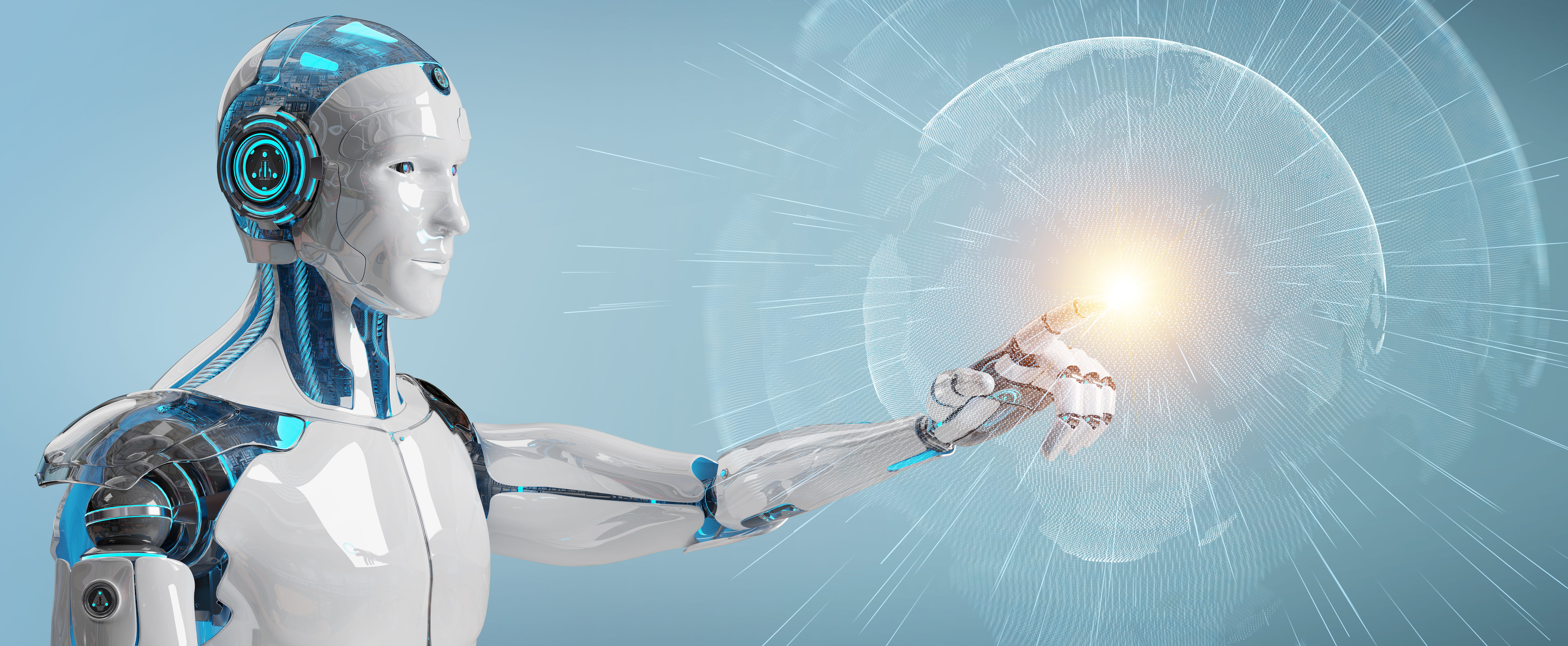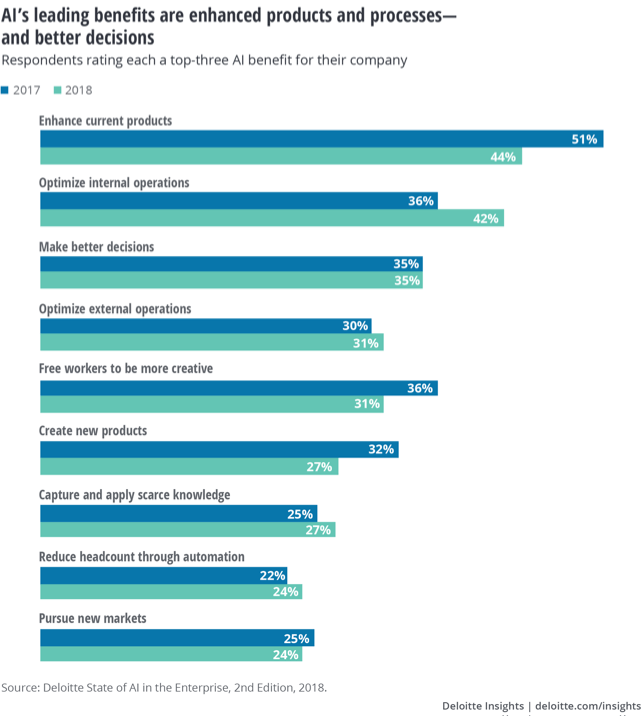
It’s 2019, and if the question “What is Artificial Intelligent?” is still in your head, you know that you are getting behind. The right question to ask is “HOW can Artificial Intelligence support you and your corporation?”.
Artificial Intelligence or AI, a non-programmed system working specifically on the collected data through observation and analysis, has been identified as one of 10 new technology trends changing the world alongside with Augmented Analytics, Blockchain or Quantum Computers (Gartner, 2018).
AI might have appeared in parts of your daily life: your Gmail Smart Reply, Alexa in your kitchen, the facial recognition in your smart phone, the suggestion of your favourite type movies on Netflix or music on Spotify or even the self-driven cars on the road and many more.
The year of 2018-2019 witnesses the strong explosion of AI and its effect towards the change of many industries and sectors. Gartner’s October (2018) survey of 3,000 CIOs showed AI was the most-mentioned technology, with thirty-seven percent of senior leaders have used or planned to use AI in their corporations in the future.
There are various ways to utilize the use of AI, with the followings are the most popular ones: Enterprise software, Co-development with partners, Cloud-based AI, Open-source development tools, Automated machine learning, Data science modelling tools & Crowdsourced development (Deloitte 2018).
By 2020, analysts predict businesses derived from AI could reach 3.9 trillion dollars and AI technology can be applied in almost every new software products and services. AI will be the top-five investment priority of more than thirty percent of global leaders. By 2023, large enterprises can have up to forty percent of their infrastructure using AI to make the process more productive. Furthermore, at lease forty percent of new application development projects will include AI co-developers in the team.
According to Deloitte’s survey (2018), eighty-two percent of companies gained financial return from their AI investment; with Technology/media & entertainment/telecommunication and Industrial products & services with the highest return on investment (Figure 1).

Figure 1: Ai Investment and ROI: Relative landscape of industry (Deloitte, 2018)
Early adopters of AI invested in AI to improve their competitiveness, with sixty-three percent of executives believed AI technologies are required to catch up with their competitors (Deloitte, 2018).
Leaders in leading corporation have planned to use AI in their business, don’t you want to stand out of the crowd?
Can we get to know about your interest in AI?
WHAT HAPPENS NEXT IN 2019?
There are various AI trends and solutions that happening in the world. FPT Software ourselves has focused on developing AI with various services, discovering here, with enormous resources and detailed strategies, which will be discussed below. The world also shows its interest in this emerging technology as Young (2019) stated about the latest notable trend of Artificial Intelligence:
1. VOICE-TO-TEXT, CHATBOT
Natural Language is the technology behind Voice-to-Text, which includes Natural Language Processing (NLP), Natural Language Understanding (NLU), Natural Language Interaction (NLI) and Natural Language Generation (NLG), is one of the most famous form of AI.
Traditionally, NLP is used in text analytics, with various use cases to rise even in the next few years. NLP also contributes in progressive speech to text and semantic search use cases (Harper, 2018). The conversational, speech recognition systems are expected to have more sophisticated algorithms than the simplistic, template – based approach.
Machine learning supports natural language, especially in text analytics. For example, when NLP understands a term in a document and parts of speech, machine learning is able to point out the relationship between them. On the other hand, when natural language is supported by deep learning, the results show higher accuracy level than by machine learning. Therefore, the conjunction between natural language and deep learning is also the one to look out for.
2. FACIAL RECOGNITION
Facial recognition has been receiving a lot of negative press recently, due to China’s SenseTime system to identify its 1.4 billion citizens (Fortune, 2018) or Google Photo’s winning lawsuit (Fingas, 2018). However, the technology is predicted to grow further more this year with higher accuracy and reliability. Some notable examples are Facebook’s Deepface program to easily tag friends in your photos, or iPhone X’s facial recognition digital password.
Facial recognition will help to personalize you experience – from your shopping experience to advertising. Payment processing through security check, law enforcement or even healthcare can also make use of this technology.
Image recognition is the core of facial recognition, with real successful examples including Google Vision, Amazon Rekognition.
On the other hand, facial recognition can be seen in technology for video surveillance or CCTV, with current technology on the market showing high accuracy and efficiency, fast detection and searching. AI for CCTV cameras or video surveillance employs computer software programs which analyze the humans, objects and vehicles. Some platforms on the market monitor human behaviors, or allow to add extensions to have analytic such as facial recognition, providing the accuracy level of 95 percent. In the future, AI for CCTV is able to offer advance object motion detection, in-depth behavioral analysis, even in active environment.
3. AI & OTHER TECHNOLOGIES
What awaits us might be the convergence of AI with other emerging technologies, such as IoT or Blockchain.
Self-driving car is the successful example of how AI and Internet of Things (IoT) work with each other. IoT allows the car’s sensor to collect real-time data and AI models are used for decision-making. Deep learning AI algorithms then use these data to take action or make decision, which include path planning, driver monitoring, eye-tracking, language processing (understand voice commands) or even self-direct to a desired planned location. Vehicles can also communicate with one another to optimize the traffic.
On the other hand, the combination of Blockchain and AI can distinguish the challenges of Blockchain: securities and scalability, and AI’s: privacy and trust issues. Blockchain can decentralized data marketplaces and turn AI algorithms to be more trust worthy and transparent; like a start-up named Enigma that allows enterprises to a secure data marketplace.
4. PRIVACY AND POLICY
Most of us are unaware of how our information is used in the digital world, any privacy crisis would stir an enterprise up and decrease their reliability. The introduction of GDPR was a popular topic in 2018 and further privacy and policy conversations will take up more conversations.
Issues such as the consent of a system usage, especially of AI applications which are still new and needs further understanding. Regulations of AI development, safety or transparency would also need to be developed in the future.
(Read more: A few thoughts on AIs and its impacts on our future)
HOW AI SOLVES THE PROBLEM?
Deloitte (2018)’s survey shows finding on the prominent benefits corporation seek when using AI, showing they are placing more focus on internal operations (Figure 2). Even though integrating AI into existing products and services is still the most popular objective, this emphasis has been reduced for more internal focus; which is understandable as operational change is required before the integration process.
Other objectives include making better decision, optimize external decisions, free workers to be more creatives also offers much more to the company.

Figure 2: Respondents rating each a top-three AI benefit for their company (Deloitte, 2018).
In general, AI can help corporations by automating and improving complex analytical tasks, increasing efficiency and accuracy, and looking at real-time data, adjusting the behavior for supervision (Maalerud, 2019).
Companies can use artificial intelligence to reduce operational costs and minimize issues in different ways such as increasing automation, optimizing asset management, improving operational performance or decrease downtime. DeepMind, a technology firm acquired by Google in 2014, uses machine learning to solve everyday problems such as reducing energy usage; they managed to reduce the amount of energy for cooling by 40 percent.
In Finance, AI is able to look at big amount of data to achieve greater analysis, predict future pricing pattern, identify new market and minimize supply chain risks. Various companies, such as Tieto - a Finnish tech company, use AI for these purposes.
AI also supports procurement to compare, analyzes a large number of suppliers, manages supply chain risks and therefore finds the best value with great quality.
In Healthcare, AI is able to detect diseases or even early form of cancers, give faster and more accurate diagnose and treatment to the patients by analyzing large amounts pf medical data. From the patient’s point of view, this can help patients make better decision, diagnose disease and avoid expensive procedures.
From government’s aspect, by placing sensors on the street and applying AI, governments can make better decisions on essential social issues, economy and the environment.
Final thoughts
The rise of AI is undeniable, as more complicated algorithms are required to solve tougher problems. The growth of this technology will continue in the next few years, with the focus on not only new emerging technologies and systems but also how AI interferes with human society.
Please stay tune in the upcoming articles to get to know more about Artificial Intelligence and FPT Software’s services. Visit here to know more about our services.
Sources
1. In China Facial Recognition Tech is watching you [link]
2. Court tosses Google Photo lawsuit [Link]
3. Gartner Identifies the Top 10 Strategic Technology Trends for 2019 [Link]
4. 2019 Trends in Natural Language Processing [Link]
5. Why does Gartner predict up to 85% of AI projects will “not deliver” for CIOs? [Link]
6. State of AI in the Enterprise [Link]
7. How Artificial Intelligence Can Solve Industry Challenges [Link]
8. 10 trends of Artificial Intelligence (AI) in 2019 [Link]






























